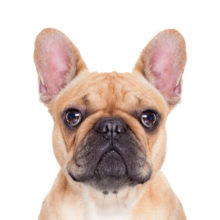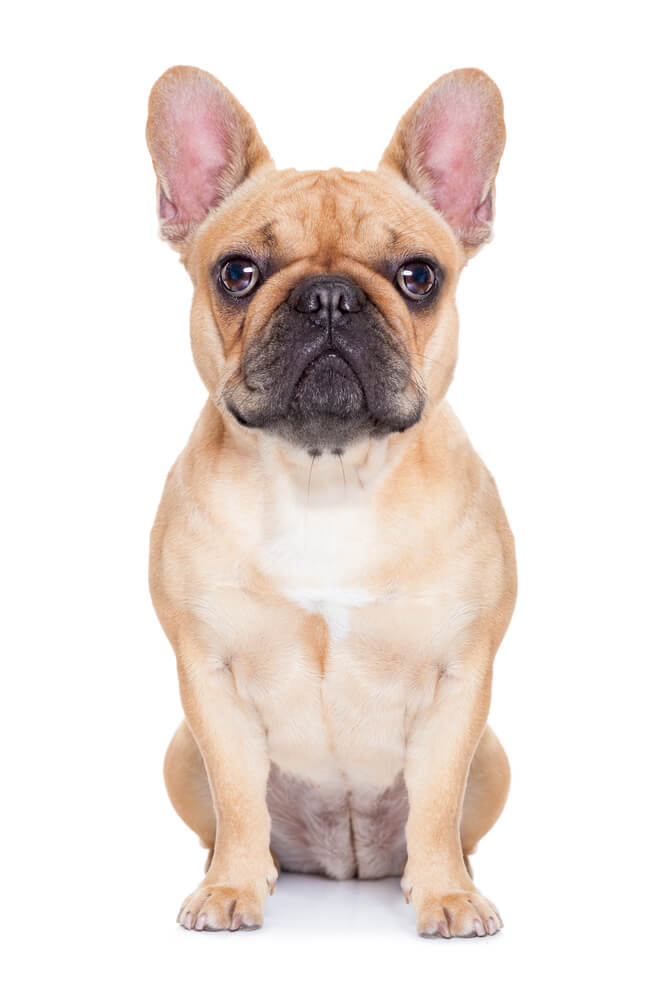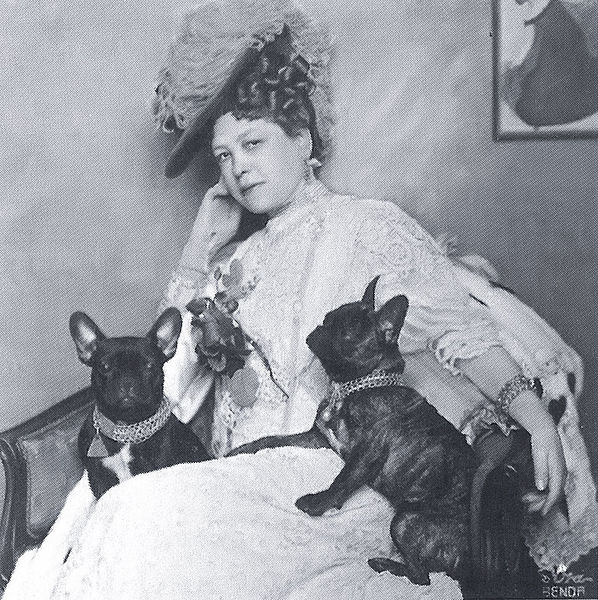French Bulldog

French Bulldog breed is originally from France,United Kingdom. Also known as Frenchie, Bouledogue Français.
French Bulldogs are small, friendly dogs. They have a cheerful, good-natured, playful personality and unusual appearance.
Breed information
| Popularity |
|
| Name | French Bulldog |
| Other names | Frenchie, Bouledogue Français |
| From country | France,United Kingdom |
| Standards | |
| Breed groups | Non Sporting (AKC),Companion (UKC) |
| Type | Purebred |
| Size | Small |
| Life span | 10 - 12 years |
| Temperament | affectionate,playful,alert,athletic,bright,easygoing,keen,lively,patient |
| Height female | 11-13 inches (28-33 cm) |
| Height male | 11-13 inches (28-33 cm) |
| Weight female | 16–25 pounds (7–11 kg) |
| Weight male | 16–25 pounds (7–11 kg) |
| Colors | brindle,brindle & white,cream,fawn,fawn & white,fawn brindle,white,white & brindle,white & fawn |
| Litter Size | 3 - 5 puppies |
| Puppy Price | Average $2000 - $4000 USD |
French Bulldog breed image

French Bulldog Pros and Cons
There are 4 pros and 2 cons of owning French Bulldog.
| Pros 👍 | Cons 👎 |
|---|---|
| Kid-friendly | Needs more attention to his health |
| Dog-friendly | Not hypoallergenic |
| Easy to groom | |
| Dog no needs regular exercises |
Breed Characteristics
| Sensitivity Level |
Low-sensitive
High-sensitive
|
High-sensitivity dogs can be deeply affected by their owner's actions. If you shout loudly at the dog, ignore it, or if your child pulls its tail, it may take offense. On the other hand, low-sensitivity dogs, often referred to as 'tolerant' dogs, handle these situations more easily. If you're an emotional person, have a busy lifestyle, sometimes neglect your dog, or have young children, we don't recommend getting a high-sensitivity dog. |
|
| Kid-Friendly |
No-Kid-Friendly
Kid-Friendly
|
Kid-friendly dogs are highly tolerant of children's behavior, including hugs and playful "games" like attempting to saddle them. They typically interact kindly and patiently with kids, making them great family pets. Not Kid-Friendly Dogs - Dogs in this category do not tolerate such behavior from children and may react negatively or even aggressively. Be cautious about bringing a not kid-friendly dog into a family environment. |
|
| Dog Friendly |
Low-friendly
High-Friendly
|
Dog-friendly characteristics vary widely, ranging from low-friendly to high-friendly. It's important to note that a dog's level of friendliness depends on several factors, and breed is just one of them. Dogs with high friendliness tend to be sociable and enjoy interacting with other dogs. They may happily play with other canines or simply remain calm and relaxed when in the company of other dogs. Conversely, dogs with lower levels of friendliness may exhibit different behaviors. They might be more prone to barking, trying to engage in fights with other dogs, or even attempting to run away from unfamiliar dogs or situations. Keep in mind that a dog's friendliness is influenced by their individual personality, upbringing, and experiences. So, it's essential to consider these factors when assessing your furry friend's social behavior. |
|
| Friendly Toward Strangers |
Not-friendly
Everyone Is My Best Friend
|
It's important to understand that a dog's behavior towards strangers is influenced by various factors, with breed being just one of them. A dog that is friendly toward strangers will typically exhibit pleasant behavior when your friends or visitors come to your home. They won't display aggression or attempt to attack them. Instead, they will likely be welcoming and sociable. On the other hand, some dogs may be naturally shy or even fearful of strangers. However, it's crucial to note that a dog's socialization plays a significant role in their behavior. Proper socialization lessons can help any dog become more welcoming to strangers, regardless of their breed. That said, if you happen to choose a breed known for its high stranger-friendly rating but don't invest time in training and socialization, the dog may still exhibit unfriendly behavior toward your visitors. Remember, a dog's behavior is a product of both their breed tendencies and their upbringing. |
|
| Amount Of Shedding |
No Shedding
Hair Everywhere
|
|
What's crucial to note is that the extent of shedding can vary from one breed to another. Some dogs shed consistently throughout the year, while others may have specific seasonal shedding patterns. There are also breeds that shed minimally, and in some cases, almost not at all. When choosing a dog, it's essential to consider your personal preferences and standards regarding shedding. Your choice should align with how much you're willing to handle in terms of grooming and cleaning to keep your home and clothes free from excessive dog hair. |
|
| Easy To Groom |
Easy
Hard
|
|
Some breeds are low-maintenance and can be brushed quickly and easily. Others may need regular clipping, grooming, and bathing to keep them looking their best. When choosing a dog, it's important to assess how much time and money you're willing to invest in their grooming needs. Your decision should align with your preferences and your commitment to providing the necessary care for your furry friend. |
|
| General Health |
Need more attention to health
Healthy as an ox
|
|
It's important to be aware that some dogs may face health challenges due to irresponsible breeding practices. One example of such health issues is hip dysplasia, which is a genetic problem. However, it's essential to understand that not every dog of a specific breed will develop these health issues, although they may be more prone to them. When adopting a puppy, it's a good practice to gather information about any genetic illnesses associated with the breed. For more detailed information, you may also want to consult with a shelter or rescue organization, as they can provide insights into the physical health of the puppy's parents or siblings. |
|
| Easy To Train |
Self-Willed
Eager to Please
|
|
It's worth noting that some dog breeds are more trainable than others. For instance, certain breeds may quickly grasp and establish associations between words like 'stay,' corresponding actions (such as staying in place), and the resulting rewards. On the other hand, some breeds may require more time and attention during training. Dogs are highly intelligent animals, but they often like to understand what's in it for them when they follow your commands. This is where games and rewards can be valuable tools in training and motivating them. |
|
| Intelligence |
Low
High
|
|
Different dog breeds excel in specific tasks and exhibit varying levels of intelligence, concentration, and quick decision-making abilities. For instance, breeds bred for their intelligence, like Border Collies, may excel in activities such as herding livestock. These dogs require more mental stimulation to thrive compared to breeds designed for physical endurance and running. Understanding your dog's specific needs is essential to ensure they are mentally engaged and don't engage in unwanted behaviors like chewing and digging. To meet these needs, consider interactive toys and activities, such as obedience training for dogs in need of mental engagement, or search and rescue activities for those with high activity levels and keen senses. |
|
| Tendency To Bark Or Howl |
Only To Alert
Avid singer
|
|
It's important to understand that vocalization varies between dog breeds. Some dogs are naturally more vocal, and they can bark and howl at different pitches. For instance, consider the hound, known for its distinctive barking and howling. You'll need to decide if the sound of their vocalizations might become bothersome or if you find it somewhat musical. Additionally, if your chosen breed has a history of hunting, they might constantly chase and howl at nearby wildlife. If you're looking for a watchdog and your dog is alert, it may bark at everyone it encounters. These factors are essential to consider when selecting a dog breed, especially if you have neighbors or are subject to any noise restrictions. |
|
| Energy Level |
Couch Potato
High Energy
|
|
A dog's energy level is often influenced by their breeding, as some breeds were designed for specific tasks like herding livestock or retrieving game for hunters. Dogs with high energy levels will require plenty of interaction and exercise. They tend to be more active and enjoy activities such as playing, running, tumbling, and exploring new smells and sights. On the other hand, some breeds are low-energy and prefer lounging on the couch with you, taking naps, and enjoying Netflix marathons. When choosing a dog breed, it's essential to consider your own activity level and lifestyle. Select a breed that aligns with your preferences and can comfortably fit into your daily routine. |
|
| Exercise Needs |
Low
Need a lot
|
|
Different dog breeds have varying requirements when it comes to physical activity. Some breeds may be content with a leisurely stroll in the evening, while others might crave several vigorous laps around the block. Their exercise needs are often linked to their original purposes, such as hunting or herding, which influence their energy levels. Dogs with high energy levels that don't receive adequate exercise may be prone to weight gain and may engage in behaviors like digging, chewing, and excessive barking. High-energy dogs tend to thrive when paired with individuals who are active, enjoy the outdoors, or have an interest in training their dog for competitions. |
|
| Potential For Playfulness |
Only When You Want To Play
Non-Stop
|
|
Dog breeds exhibit a wide range of personalities, and this includes their inclination for play. Some breeds are consistently playful and seem to stay in a perpetual puppy state of mind. In contrast, other breeds tend to be more serious and enjoy their moments of relaxation. When choosing a dog, it's important to consider whether the idea of having a playful companion excites you or if you prefer a more relaxed and laid-back dog. Additionally, factors such as the presence of children or other pets in your household should be taken into account. Another option to explore is adopting an older dog, which might be less demanding but still enjoys interacting and playing, providing a balance between playfulness and a calmer demeanor. |
|
French Bulldogs are attached to all family members, great companions[5], and get along well with children. They are incredibly successful due to their temper and compact size.
French Bulldogs are sociable, cheerful, mobile, exceptionally affectionate with the owners, get along great with children and love to play.
Basic moments
- These dogs are smart, but stubborn, they quickly get bored with routine. The trainer will have to show ingenuity and patience.
- Pets do not need high physical activity. Regular walks and weight control are enough[5].
- Representatives of the breed do not tolerate heat well, it is recommended to keep in an air-conditioned room[5].
- French Bulldogs make little noise, rarely bark[5], although there are exceptions.
- These dogs are not suitable for lovers of perfect cleanliness: they drool, are prone to flatulence, molt.
- The French Bulldog breed is only suitable for keeping in the house - they are not physically adapted to life on the street.
- A companion dog needs a lot of human interaction. If left alone for more than a few hours, they may experience separation anxiety[3][4]. If no one is at home for a long time, the dog may grow up aggressive or get sick.
- The French Bulldog will get along well with a child, but it is better not to leave very young children with a pet unattended by adults - the baby can accidentally offend the dog, forcing it to defend itself.
History of the French Bulldog breed
French Bulldogs, despite their name, were bred in England. In the 19th century, breeders decided to create a companion dog breed that could be kept in an urban environment without much difficulty. Craftsmen, seamstresses, lace makers did not miss the opportunity to acquire a mischievous pet, which pleased the owners with a light disposition and funny habits. To breed such a dog, breeders selected the smallest English bulldogs, crossed them with terriers, pugs. This is how the modern breed appeared.

In the second half of the 19th century, the demand for manual labor fell sharply due to the rapid development of manufactories. Many English workers moved to France with their beloved dogs. According to another version, traders brought the bulldogs here. The good-natured character, the ability to catch small rodents and unusually large erect ears instantly riveted the attention of the French public to this breed.
In Paris, courtesans became the first owners, or rather the owners, of little bulldogs. There are many photographic postcards with nude or semi-nude women posing with their pets. Very quickly, the fashion for these dogs spread in high society, as evidenced by numerous photographs. Since the 80s of the XIX century, a real boom in the popularity of the breed began. At this time, Paris was already the fashionable capital of the world, so the whole world soon learned about the French Bulldogs. In 1890, the dogs were brought to the United States, and after 7 years the FBDCA (French Bulldog Club of America) was established.
The French Bulldogs made their debut to the general public at the English Show in 1896, where they won the admiration of many dog breeders. The breeders became interested in breeding these dogs. The popularity of the breed grew rapidly, and in 1913 about a hundred French Bulldogs arrived at the Westminster show. Originally these dogs were called bouledogue français in French , but at the beginning of the 20th century the name was changed to French Bulldog. The Kennel Club in 1905 recognized the breed as an independent breed, separating it from the English Bulldogs.
Appearance of French Bulldogs
The standard for French Bulldogs was developed at the time of the beginning of the exhibitions with their participation. The main criteria allow you to select the best representatives of the breed: healthy, suitable for show and breeding.
Dimensions
They are small, compact dogs. Adult males weigh about 10-15 kg, females 8-12 kg. The height at the withers is not officially limited by the standard, but usually it does not exceed 25-35 cm.[6]
Coat
The coat of French Bulldogs is smooth, shiny and thin, the cover fits well to the body and does not have an undercoat, therefore, it is worth insulating the dog for walking in frosts.
Body
The French Bulldog has a strong square build. The back and hind legs are well muscled and strong.
Front legs
The front legs are somewhat shorter than the hind legs, which visually makes the dog slightly stooped. Because of this feature, pets love to lie in a funny pose - stretching their hind legs back. The weighted body and short legs do not allow the French Bulldog to swim (it can stay upright in the water and gets tired quickly).
Head
Wide and square, so the breed is undershot. Some puppies are born with an elongated or split soft palate.
Muzzle
On the forehead there are wrinkles characteristic of the breed, turning closer to the middle into symmetrical concentric folds, the muzzle is short. The small nose is flattened and turned up. The forehead has a convex profile, the neck is covered with folds. The eyes are large, round with a benevolent expression. Difficulty breathing, accompanied by sounds similar to grunting.
Ears
The hearing organs are long, straight, rounded at the ends.
Color options
Fawn, white, black, brindle, spotted, Pied Color, beige, white brindle, blue (not recognized by all associations), cream.
Reference:
- History of french Bulldog. wikipedia
- FBDCA. frenchbulldogclub
- McCrave, Elizabeth A. (March 1991). "Diagnostic Criteria for Separation Anxiety in the Dog". Veterinary Clinics of North America: Small Animal Practice.
- Schwartz, Stefanie (June 2003). "Separation anxiety syndrome in dogs and cats" (PDF). Journal of the American Veterinary Medical Association. 222 (11): 1526–1532.
- "Get to Know the French Bulldog", The American Kennel Club
- Coile, D. Caroline (2005). French Bulldogs. Hauppauge, N.Y.: Barron's
Video about French Bulldog breed
Questions and answers about French Bulldog
The average life expectancy of a French Bulldog is between 10 - 12 years.
If your French Bulldog is pregnant, it is safe to assume that litter can have anywhere from 3 to 5 puppies.
If you purchase French Bulldog from a breeder it can be much more expensive than a shelter. A purebred French Bulldog costs between US$ 2000 and US$ 4000 from a reputable breeder, but there are several advantages to doing so. First, a breeder will usually allow you to meet the parents to get a good idea about what the puppy will look like and behave. You will also see if the parents have any health problems. Breeders will also supply you with paperwork that documents your pet’s lineage.
Definitely, YES, French Bulldog is the most widely favored and beloved purebred dog in the United States of America. French Bulldog have got #2 rank in 2020 and #2 in 2021, #1 in 2022 by American Kennel Club (AKC).
No, French Bulldog are not considered hypoallergenic dogs. If you are thinking about getting a French Bulldog and have allergies, it's important to spend time with the breed to see how you react before bringing one into your home. This can help you make an informed decision about whether a French Bulldog is the right pet for you, and if so, what steps you may need to take to manage any allergy symptoms.
- https://www.akc.org
- FCI standard
- Kennel club standard
- Wikipedia https://en.wikipedia.org/wiki/French_Bulldog
Next and previous breeds by Popularity

Labrador Retriever
Popularity: №2